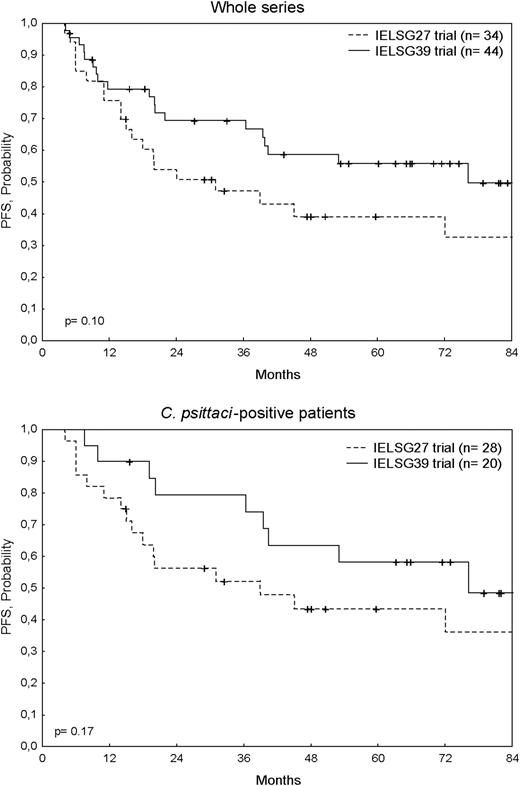Abstract
Background: Overall survival of patients with limited-stage ocular adnexa MALT lymphoma (OAML) is favorable, with a few lymphoma-related deaths. In geographical areas where OAML is frequently associated with Chlamydia psittaci (Cp) infection, bacterial eradication with doxycycline monotherapy is associated with good disease control. In the IELSG27 trial (Ferreri, et al. JCO 2012), a 3-week regimen of doxycycline has been associated with an overall response rate (ORR) of 65% and a 2-year progression-free survival (PFS) of 60%. However, successful Cp eradication has been achieved only in half of patients, which strongly conditioned therapeutic results. This phenomenon is explained by the fact that, during its biological cycle, Cp often persists within macrophages under the form of elementary bodies, which is a metabolically inert condition, refractory to antibiotics. An extended exposure to effective antibiotics could result in a higher bacterial eradication rate and better lymphoma control. This hypothesis was tested in an international phase II trial (IELSG39), where patients with limited-stage OAML were treated with a six-month regimen of doxycycline. Herein, we report primary endpoint results.
Methods: HIV-negative adults with newly diagnosed stage IEA OAML, ECOG-PS 0-2 and measurable disease were enrolled and treated with doxycycline 100 mg twice daily for four weeks followed by four weeks rest, repeated for three times (treatment duration: six months). Patients with HBV or HCV seropositivity, myasthenia gravis or systemic lupus erythematous were excluded. Cp infection was assessed by TETR-PCR analysis on tumor tissue at diagnosis and monitored on conjunctival swabs and PBMC every six months. Tumor response was assessed by orbit MRI and ophthalmologist evaluation every six months. The primary endpoint was the 2-year PFS, a Fleming phase 2 design was used. The main goal of this experimental treatment was to improve the efficacy of antibiotic therapy reported in the IELSG27 trial (2-year PFS= 60%; P0) to a 2-year PFS of 75% (P1). To detect such a difference, a total number of 30 patients with Cp-positive OAML was required (one-sided test, type I error 5% and power 80%); whenever ≥17 patients with Cp-positive OAMZL were progression-free at 2 years, the experimental therapy would be considered effective.
Results: 44 patients (median age 58 yo, range 31-85; male:female ratio 0.63) were enrolled in eight participating centres, between March 2013 and May 2016. Lymphoma site was conjunctiva in 27 (61%) patients, orbit soft tissues in 10 (23%), lachrymal gland in 6 (14%), and eyelid in one (2%). Cp DNA was detected in 20 (71%) of 28 assessed patients; TETR-PCR analysis is ongoing in 16. Treatment was well tolerated; all patients completed the treatment in the planned time. Grade 1-2 nausea was complained by 8 (18%) patients. The best objective response was complete in 14 patients and partial in 14, with an ORR of 64% (95% CI= 50-78), 11 patients had stable disease, and five experienced progressive disease. The time to the best response was longer than one year in 11 (46%) of 24 patients with responsive disease (median 9 months; range 3-34).
At two years from enrolment (primary endpoint), 30 patients remain relapse-free; 17 of them had a Cp-positive OAML. At a median follow-up of 79 months (range 33-112), 23 patients remain relapse-free, with a 2- and 5-year PFS of 72% (95%CI= 71-73) and 53% (95%CI= 47-58), respectively; all patients are alive. Patients with Cp-positive lymphoma had a better PFS (5-year: 60% and 37%; p= 0.14). A post-hoc explorative analysis showed that this six-month doxycycline treatment was associated with a trend towards better PFS in comparison with the shorter regimen used in the IELSG27 trial (median follow-up 75 months; range 5-155), both when whole populations (upper figure) and Cp-positive subgroups (lower figure) were considered.
Conclusions: The assessed six-month administration regimen of doxycycline was safe and effective in patients with stage-I OAML. This experimental treatment achieved the predetermined efficacy threshold and compares favorably with the 3-week regimen used in the IELSG27 trial, suggesting that a prolonged exposure to antibiotics improves lymphoma control.
Disclosures
Cavallo:Amgen: Other: Expenses for EHA virtual meeting; Roche: Membership on an entity's Board of Directors or advisory committees, Other: Expenses for Ash meeting; Takeda: Other: Expenses for ICML virtual meeting; Servier: Speakers Bureau. Mannina:GlaxoSmithKline: Membership on an entity's Board of Directors or advisory committees. Bertoni:Helsinn: Research Funding; Polyphor: Research Funding; Neomed Therapeutics 1: Research Funding; Nordic Nanovector ASA: Research Funding; Menarini ricerche: Other: consulting fee, Research Funding; Curis: Research Funding; AstraZeneca: Other: travel support; Bayer: Research Funding; ADC Therapeutics: Research Funding. Zucca:MSD: Other: expert statements; Incyte: Other: advisory board fee, Research Funding; Bristol-Myers Squibb: Other: expert statements; Gilead: Other: travel grant, expert statements; Abbvie: Other: travel grant; Celltrion Healthcare: Other: advisory board fees ; Astra Zeneca: Other: advisory board fees ; Mei Pharma: Other: advisory board fees ; Janssen: Research Funding; Roche: Research Funding; Celgene: Other: advisory board fees, Research Funding; BeiGene: Other: advisory board fee, Research Funding; Miltenyi Biomedicine: Other: advisory board fee.
Author notes
Asterisk with author names denotes non-ASH members.


This feature is available to Subscribers Only
Sign In or Create an Account Close Modal